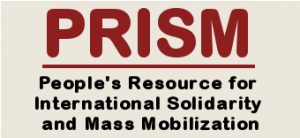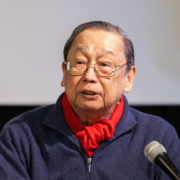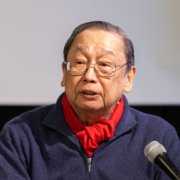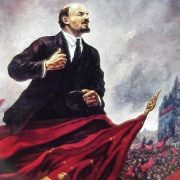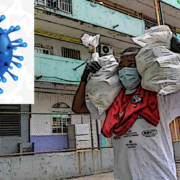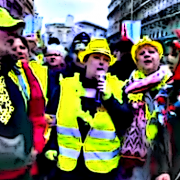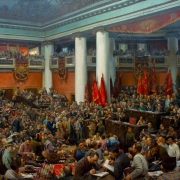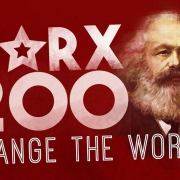On the 20th anniversary of the September 11, 2001 attacks on New York City’s World Trade Center and the Pentagon building near Washington D.C., Jose Maria Sison delivered a major speech, “On 9-11 and the US War on Terror” at a webinar on 13 September 2021. Prof. Sison is chairperson emeritus of the International League of Peoples’ Struggle.
Read moreMajor events of global and historic impact, including commemoration of such events
On the occasion of US imperialism’s failed 20-year occupation of Afghanistan, which ended ignominiously on 31 August 2021, Jose Maria issued this article, “US Occupation of Afghanistan from 2001 to 2021.” Prof. Sison is chairperson emeritus of the International League of Peoples’ Struggle.
Author’s note: This article is focused on the US-NATO war of aggression against Afghanistan and its occupation from 2001 to 2021. It may be distributed in connection with my paper on 9-11 and the War on Terror for the webinar on September 13, 2021 under the sponsorship of BAYAN and the ILPS-Philippines.
The editors of PRISM are posting this paper by Prof. Jose Ma. Sison about V.I. Lenin’s 150th birth anniversary, one week before the actual birthday of the great Marxist revolutionary thinker, leader and author. We offer it to all our readers as part of our contribution to the expected worldwide commemoration of his birth, life and work and historic legacy. Many socialist and anti-imperialist parties and groups are likewise marking that date with their own activities, which might be reduced in terms of physical scale because of the ongoing Covid-19 pandemic but certainly maintaining high levels of militance and confidence about the forward movement of the struggles of the proletariat and peoples throughout the world.
Read moreOn 9 April 2020, Prof. Joma Sison held a forum via Facebook Live to an online audience of nearly 300 people. Here he gave a concise summary of the current international situation replete with major earth-shaking events unfolding before our eyes, including the Covid-19 pandemic and what is shaping out as the beginnings of a new Great Recession equal to or even worse than the Great Depression of 1929 onwards to the 1930s. Sison explained that “the world capitalist system was already in trouble even before the Covid-19 pandemic arose. And the pandemic has unmasked and aggravated the crisis of global capitalism. It is of urgent importance to know how the people are affected and how they are responding.”
The full text of Sison’s paper follows. Please note links to Pages 2 and 3 at the bottom.
Read moreProfessor Jose Maria Sison, chairperson of the International League of Peoples’ Struggle (ILPS), favorably compares France’s yellow vest movement “with the May 1968 mass protests in France, especially with regard to militancy and opposition to the capitalist establishment.” He says that the yellow-vest protestors “enjoy the support of the broad masses of the people” who condemn French neoliberal banker turned president Emmanuel Macron. While the movement “suffers from the same excessively horizontalist populist character” and the lack of revolutionary proletarian leadership, Sison emphasizes that the “yellow vest movement is welcome and praiseworthy for taking up the just grievances of the working class and the middle class and exposing the grave ills of the oppressive and exploitative capitalist ruling system.” Full text of the ILPS chairperson’s statement follows.
On the yellow vest movement in France
By Prof. Jose Maria Sison
Chairperson, International League of Peoples’ Struggle
March 19, 2019
On 17 November 2018, 300,000 people of the working class and the middle class mainly from the suburban and rural areas of France rose up in militant mass demonstrations to protest the fuel tax hike and rising fuel prices. Characteristically, they wore the yellow vest to signal their economic and social distress. They had been inspired by an online petition signed by almost one million people.
Eighteen mass demonstrations, centered in Paris and carried out nationwide, broke out up to the most recent one of March 16, 2019 dubbed as “The Ultimatum”. The just demands of the yellow vest movement have expanded from the lowering of fuel taxes to the reintroduction of the solidarity tax on wealth, increase of the minimum wage, expansion of social services, the implementation of citizen’s initiative referendums and the resignation of President Macron and his regime.
The Macron regime has responded with a heavy hand by launching physical attacks by the police on the demonstrators with the use of water cannons, tear gas grenades, flash balls and baton charges. It is but just that the demonstrators have fought back with the use of sticks, cobblestones, car blockades, control of roads and roundabouts, destruction of traffic surveillance cameras, the burning of the expensive cars of the big bourgeois and mass entries to the upper class restaurants and shops.
The yellow vest demonstrators enjoy the support of the broad masses of the people who condemn Macron, the investment banker turned president, as the promoter and enforcer of the neoliberal policy which favors the big bourgeoisie and its best-paid executives at the expense of the workers and the rural people. They are enraged by the use of police violence during mass actions and by the false promises made by Macron before and after every mass action.
The yellow vest movement has influenced similar mass movements in Europe and elsewhere in the world, whose participants wear the yellow vest and raise demands against the tax and other exploitative policies of the big bourgeois government. Most of the influenced movements have a benign and progressive character directed against the exploitative policies of bourgeois governments. But a few are directed against migrant workers and others unrelated to the monopoly bourgeoisie.
The yellow vest movement may be favorably compared with the May 1968 mass protests in France, especially with regard to militancy and opposition to the capitalist establishment. But it suffers from the same excessively horizontalist populist character and the lack of leadership from a revolutionary party of the proletariat. It may also be compared with the Occupy Movement of recent memory, which enjoyed popular support for a certain period. But this fizzled out for lack of leadership from a revolutionary party of the proletariat.
At any rate, such a phenomenon as the yellow vest movement is welcome and praiseworthy for taking up the just grievances of the working class and the middle class and exposing the grave ills of the oppressive and exploitative capitalist ruling system. It shows that there is a wide and deepgoing mass base of social discontent and resistance that the Marxist-Leninist revolutionary party of the proletariat can avail of in winning the battle for democracy and aiming for the socialist revolution.###
Source URL: https://josemariasison.org/on-the-yellow-vest-movement-in-france/
By JOSE MARIA SISON
Founding Chairman
Communist Party of the Philippines
(Reestablished in 1968)
We joyously celebrate this year the 100th anniversary of the establishment of the Third International or the Communist International (Comintern) by its First Congress in Moscow on 2-6 March 1919. The Comintern succeeded in encouraging the formation and development of Communist Parties in many countries and in advancing the world proletarian revolution. It has had far-reaching revolutionary influence and consequences beyond its 1943 dissolution.
The Comintern was the logical and necessary outcome of the victory of the Great October Socialist Revolution, which made Russia the center of the world proletarian revolution. It was in clear repudiation of the bankrupt opportunist and revisionist line of the Second International, which had turned the social democrats into social-chauvinist and social-pacifist subalterns of imperialism in capitalist exploitation, colonialism and waging aggressive war.

Even as the Bolsheviks were under the pressure of the Civil War and the foreign interventionist war of the Entente powers, Lenin saw the necessity of founding the Communist International in order to promote the proletarian revolution, especially in Germany and other European countries exhausted by World War I and disgusted with their rulers. He was motivated by the spirit of proletarian internationalism and he calculated that further revolutions in Europe would be helpful to the survival of the Soviet Union.
Concurrently, he recognized the revolutionary potential of the working peoples in the colonies in the East as the imperialist system was breaking down. It was the duty of the Soviet people to themselves and to other peoples to advance the world proletarian revolution. When the revolutionary flow in Europe ebbed, the revolutions of the East were bursting out, especially in neighboring China.
I. The Communist International vis-à-vis the Colonies like the Philippines
The program of the Comintern optimistically declared that the imperialist system was breaking down and that there was ferment in the colonies, among the former dependent small nations, insurrections of the proletariat, victorious proletarian revolutions in some countries, dissolution of imperialist armies, complete incapacity of the ruling classes to guide the destinies of the people. The program expected the working class to create genuine order–a communist order–by destroying the rule of capital, making war impossible, abolishing state frontiers, changing the entire world into one cooperative community, and realizing the brotherhood and freedom of the peoples.
The great Lenin challenged the delegates to the Congress of Communist Organizations of the Peoples of the East in Baku on November 22, 1919: “You are representatives of communist organizations and communist parties of various Eastern peoples. I must say that the Russian Bolsheviks succeeded in forcing a breach in the old imperialism, in undertaking the exceedingly difficult, but also exceedingly noble, task of blazing new paths of revolution,whereas you the representatives of the working people of the East have before you a task that is still greater and newer. … The period of awakening of the East in the contemporary revolution is being succeeded by a period in which all the Eastern peoples will participate in deciding the destiny of the whole world, so as not to be simply an object of the enrichment of others. The peoples of the East are becoming alive to the need for practical action, for every nation to take part in shaping the destiny of all mankind.”
In his “Draft Theses on the National and Colonial Questions” for the Second Congress of the Comintern on June 5, 1920, Lenin declared: “…the Communist International’s entire policy on the national and colonial questions should rest primarily on a closer union of the proletarians and the working masses of all nations and countries for a joint revolutionary struggle to overthrow the landowners and the bourgeoisie. This union alone will guarantee victory over capitalism, without which the abolition of national oppression and inequality is impossible.”
Lenin further wrote, “With regard to the more backward states and nations, in which feudal or patriarchal-peasant relations predominate, it is particularly important to bear in mind: first, that all Communist parties must assist the bourgeois-democratic liberation movement in these countries, and that the duty of rendering the most active assistance rests primarily with the workers of the country the backward nation is colonially or financially dependent on”.
In the “Theses on the National and Colonial Questions” it adopted in July 1920 during its Second Congress, the Comintern proclaimed: “All communist parties must support by action the national-revolutionary movements in colonial countries. The form which this support should take should be discussed with the communist party of the country in question, if there is one. This obligation refers in the first place to the active support of the workers in that country on which the backward nation is financially, or as a colony, dependent.” The Program of the Comintern would subsequently include the following: “The Communist Parties in the imperialist countries must render systematic aid to the colonial revolutionary movement, and to the movement of oppressed nationalities generally.”
In its 5th Plenum in April 1925, the Comintern approved its first resolution on the Philippines. This urged the American communists to support the national liberation movement in the Philippines and to encourage the formation of a Communist Party from the revolutionized trade union and peasant movement as well as that of a national-revolutionary mass party from all groups actively campaigning for national independence. Through the Communist Party of the USA (then known as the Workers Communist Party up to 1930), the Comintern would take the task of encouraging and assisting the organization of the communist party in the Philippines.
The Filipino workers themselves would have to organize their own party, taking into account objective conditions and subjective capabilities. Since its Second Congress in 1920, the Comintern had adopted the terms of admission which required that all decisions of the Comintern are binding on all affiliated parties but at the same time enjoined itself and its Executive Committee to take into account the diversity of conditions in which the various parties have to fight and work and to adopt decisions binding only on matters in which such decisions were possible.
II. Initial Contacts with the Comintern and American Communists
The Comintern established a number of revolutionary organizations of working people. These included the Red International of Labor Unions (or RILU or its Russian abbreviation Profintern) which was organized in 1921 and the Peasants’ International (or Krestintern) in 1923. Subsequently, subsidiary offices of these were established in China in order to cover 3the Far East and Pacific area.
Under the auspices of the RILU, the Conference of the Pacific (Oriental) Transport Workers was held in Canton, China on June 18-24, 1924. Five Filipino delegates were able to attend. To enable them to attend, the American Communist named Alfred Wagenknecht (otherwise known by his alternate names as William Elliot or Mateus Girunas) brought the invitation to the Philippines, made a survey of the labor organizations and arranged the trip of the chosen delegates who accompanied him to Canton.
The delegates came from various Philippine trade unions. They were able to meet and discuss with labor leaders from China, Indonesia, Japan, Korea, Australia, USA, England, France and USSR. They were also able to bring home a resolution of the conference calling for the immediate independence of the Philippines from US colonial rule and another resolution urging the Asian workers and peasants to organize unions and struggle against imperialism and the local exploiters. Upon their return home, they were enthusiastic and formed a “Bolshevik secretariat” to issue a secret periodical.
The communication links with Comintern organizations, the flow of publications from the Communist International and consultations with visiting American, Chinese and Indonesian communists had begun and eventually helped to stimulate a leftward trend in the Philippine labor movement, amidst the worsening social conditions and upsurge of anti- imperialist and class struggles.
From 1924 to 1928, cadres of the CPUSA (known up to 1925 as the Workers Party of America and then as the Workers Communist Party), who were linked to the China-based RILU Pan-Pacific branch, visited the Philippines and interacted with Filipino labor leaders. They included Harrison George (who represented the union of the US railroad workers) and Earl Browder before he became the secretary of the Pan-Pacific Trade Union Secretariat (PPTUS). They represented the CPUSA-led US Trade Union Educational League (TUEL) in the RILU’s Pan-Pacific branch, located at different times in Canton, Hankow and Shanghai.
A permanent Pan Pacific Trade Union Secretariat (PPTUS) was established. On behalf of American workers, Harrison George pushed a resolution expressing solidarity with the workers and peasants in the Philippines and support for their struggles for national freedom and emancipation from exploitation. In its 15th convention on June 30 to July 1, 1927, the Congreso Obrero de Filipinas declared its adherence to the PPTUS and pledged efforts towards the realization of the Program adopted in the Hankow conference. The COF and the Kalipunang Pambansa ng mga Magbubukid ng Pilipinas (KPMP, National Federation of Peasants of the Philippines) affiliated with the PPTUS. The KPMP also started to communicate with the Peasants’ International (Krestintern).
III. Evangelista Visit to Moscow and Filipino Workers as Students
In March 1928 the RILU invited Crisanto Evangelista and Cirilo Bognot of the COF to attend the 4th congress of RILU in Moscow. At the same time, the Peasant International also invited Jacinto Manahan of the KPMP to attend its conference. They passed through Shanghai in February to consult with Earl Browder and other PPTUS cadres. Evangelista and Manahan stayed for three months in Moscow. They had lengthy discussions with the Political Secretariat of the Comintern on the question of organizing the vanguard working class party in the Philippines.
The Secretariat adopted a resolution on April 20, 1928, “The Main Tasks of the Communists in the Philippines”. It put forward the following: “the primary and necessary condition for the establishment of a communist party is the formation of an initiating communist group that has educated itself in the revolutionary spirit of Marxism-Leninism, that has studied the principal lessons of the experiences of the international communist movement, that has learned how to apply that experience to the particular conditions of the working class movement in the Philippines, and that can undertake to transform gradually the Labor Party (Partido Obrero) into a party of the masses, into an effective communist party.”
Evangelista proposed the sending of Filipino workers to study in Moscow in April 1928. He visited the Communist University of the Toilers of the East and talked with the director and educational coordinators of the Profintern and Krestintern. Earlier in October 1927, after his visit to the Philippines in September, Harrison George had already recommended that the Comintern invite six Filipinos every year to study in Moscow at the communist university.
Upon his return to the Philippines, Evangelista arranged for three young workers to study in Moscow. They studied at the Communist University of the Toilers of the East. This was a special secondary school for students from Asia, preliminary to admission to the higher institute Lenin School. The schoolmates of the Filipinos were from China, Indochina, Mongolia, Korea, India, Indonesia and the autonomous Soviet Asian republics in the Caucasus and Siberia. The biggest number of non-Soviet students were the Chinese.
The subjects in the university included dialectical and historical materialism, political economy, world history, history of the labor movement, natural sciences, physics and mathematics. They had rudimentary military training and educational tours. Their teachers were English speaking Soviet professors and an American communist cadre in the Comintern, Eugene Dennis, who gave lectures on trade unionism. He would later travel to the Philippines under the name of Tim Ryan.
One of the young Filipino workers finished the full course of three years and joined the KOMSOMOL or Young Communist League of the USSR. The American communist cadre Sam Darcy assigned to the Comintern gave him briefings on Party work. Upon his return to the Philippines in November 1931, he became active in the work of Party education. Another young Filipino worker who finished only two years of the course, returned earlier to the Philippines and became a delegate to the First Congress of the CPP on May 30, 1931.
In June 1929 two more Filipino workers were sent to Moscow to study at the Communist University of the Toilers of the East. One of them, Emilio Maclang, finished the three-year course and stayed on for one more year to translate texts and documents into the Philippine national language. Upon return to the Philippines in 1933, he was chosen as the head of the second line of leadership. He became the underground secretary of the CPP as soon as the open leaders of the CPP were imprisoned and banished in 1931.
American communist cadres appeared prominently as the most helpful to the Filipino cadres in the formation of the CPPI. But comrades of other nationalities, especially the Chinese were also helpful, especially because they had their own labor and youth organizations in the Philippines. The Philippine branch of the Chinese Communist Party (CCP) was established in the early 1920s, much ahead of the establishment of the Communist Party of the Philippine Islands (CPPI). “Comrade C” who led the aforesaid branch was a longtime close comrade of Crisanto Evangelista in the trade union movement. .
The Chinese communists organized the Philippine Chinese Labor Federation (PCLF). This had close ties with the COF and the Partido Obrero. In October 1929 the Chinese Communist Party and its Young Communist League decided that the Chinese communists should assist the efforts of Partido Obrero in forming the Communist Party of the Philippine Islands (PCCI). At the same time, the contacts of the PCLF with the Profintern were coursed through the leadership of the Partido Obrero. When the PPTUS transferred from China to Vladivostok, the PCLF continued to receive Chinese language publications through Partido Obrero.
IV. The Foundation of the Communist Party of the Philippine Islands
In the year before the establishment of the Communist Party of the Philippine Islands (CPPI), the Great Depression engulfed the world capitalist system. The economic and social conditions deteriorated rapidly. The toiling masses of workers and peasants were restive. Workers’ strikes and peasant uprisings spread. There was widespread clamor for national independence against the US colonial regime and class struggle intensified against the local comprador big bourgeois and the landlord classes. The objective conditions were rife for establishing the CPPI.
Twenty-seven out of the 35 labor federations and associations in the COF broke away to form the Katipunan ng mga Anakpawis ng Pilipinas (KAP, Proletarian Labor Congress of the Philippines). The KAP and the Kalipunang Pambansa ng mga Magbubukid ng Pilipinas (KPMP, National Federation of Peasants in the Philippines) became the organized mass base of the prospective CPPI. The PPTUS recognized the KAP as the legitimate representative of the organized workers in the Philippines. The CPUSA-led Trade Union Unity League (TUUL) reserved a seat in its National Executive Committee for a KAP representative by way of honoring the KAP.
After the formation of the KAP, the Committee for a Vanguard Workers’ Party was set up in order to recruit the initial communist members. By June 1930, there were 96 of them. Fifty per cent were industrial workers, 25% peasants and 25% handicraft workers and office clerks. Most were recruited from the KAP unions. At about this time, 60 Chinese communists from the PCLF and YCL were ready to join the CPPI but retained their autonomous all-Chinese nuclei.
A convention organized the party on August 26, 1930 and elected the First Central Committee, with 35 members. The Political Bureau was composed of Crisanto Evangelista, Antonino D. Ora, Jacinto G. Manahan, Juan N. Feleo, Felix Caguin Urbano Arcega and the Chinese “Comrade C”. It elected Evangelista as general secretary and Antonino D. Ora as chairman. Subsequently, the party was formally launched at a public rally on November 7, 1930, to mark the anniversary of the Great October Socialist Revolution. During the rally, 3000 of the 6000 attending masses of workers and peasants filled up the forms to apply for party membership.
Among the aims of the CPP were the following: to struggle for the immediate, complete and absolute independence of the Philippines, to fight for the overthrow of American imperialism that dominates the Philippines, to struggle against the exploitation of the masses and to defend their liberties, to struggle for the overthrow of the capitalist system, to strengthen the unity of the labor movement and in particular the unity of the workers and peasants; to struggle against reformism and opportunism in the labor movement, to establish a Soviet or communist form of government under the authority and direction of the masses; and to unite with the revolutionary movement internationally, including the Soviet Union and liberation movements in the colonies.
Unlike other communist parties in East Asia, the CPPI was established legally and openly, despite its proclaimed aim of overthrowing US imperialism and the capitalist system. It was therefore vulnerable to illegalization a few months after its establishment. The US colonial authorities conducted close surveillance on and disrupted the legal mass actions of the newly-founded party in 1931. They made a mass arrest of the leaders of the CPPI and the delegates to the First Congress of the Party. They filed charges of sedition and illegal association against the party leaders, who were subsequently sentenced to imprisonment and exile in 1933 after a series of court appeals.
V. First Congress of the Newly-Founded Party
Soon after the founding of the CPPI, the Comintern sent the American communist Eugene Dennis (Tim Ryan) to the Philippines in order to inquire into and report on the Party’s situation and make recommendations. He reported that the CPPI had considerably broad influence and that its crystallization was of tremendous significance to the workers and peasants and to the revolutionary movement as a whole and laid the basis for the rapid development of the national liberation movement under proletarian class leadership. But he also found out that the party was lagging far seriously behind in the development of the strike movement among the workers (with only a few of the strikes led by the CPPI) and in organizing the growing mass discontent of the peasantry.
Following the recommendations of Dennis in his “The Present Situation in the Philippines and the Immediate Tasks of the Communist Party,” the Comintern advised the CPPI to hold the First Party Congress within six months and to make intensive preparations for it at lower levels of the party, including discussion of a draft program. The party was warned that its legal existence would be of short duration because US finance capital was preparing to suppress the party. It was therefore advised to build an underground apparatus that was not isolated from the masses but still linked to them through mass organizations and mass struggles.
The CPPI took the Comintern advice and held its First Congress on May 30, 1931. The 400 delegates were very representative of the toiling masses. The resolutions tackled the political and organizational problems in line with Comintern recommendations. The spirit of proletarian internationalism was manifested by resolutions in solidarity with the Chinese workers and in support of the Soviet Union and by decisions strengthening ties between KAP and the PPTUS as well as with the Trade Union Unity League led by the CPUSA. The Congress passed a resolution formally applying for affiliation to the Comintern. The CPPI received a reply dated September 7, 1931, with the following content:
“The Executive Committee of the Communist International greets the formation of the CPPI and approves the decision of the 1st Congress of the CPPI in May 1931 to request affiliation to the CI. This decision will be presented to the 7th World Congress of the CI for confirmation.
“The establishment of a new sector of the CI in the Philippines reflects the rapid growth of the national revolutionary movement in the colonial countries. Moreover, it marks an historical turning point in the development of the Philippine revolution away from the treacherous path of national reformism and on to the road of organized revolutionary struggle under the banner of the Communist Party, the vanguard of the working class. It indicates the developing revolutionary upsurge in the Philippines and the political awakening of the Filipino proletariat and peasant masses. It expresses their determination to fight for a revolutionary way out of the capitalist crisis, for the complete and immediate emancipation of the Philippines from the rule of American imperialism and its native lackeys, and for the establishment of a workers’ and peasants’ government.
The organized crystallization of the Communist movement in the Philippine Islands and its affiliation to the CI—the leader of the world organized revolution—further signifies coordination of the national liberation movement in the Philippines with the revolutionary struggle in other colonial and semi-colonial countries and with the proletarian movement in the Soviet Union and in the capitalist countries, particularly in the United States; and represents the surest guarantee for the victorious carrying through of the anti-imperialist and agrarian revolution in the Philippines. Simultaneously, it strengthens the international fighting front of the workers and peasants and colonial slaves the world over, and expresses their growing confidence to struggle under the leadership of the CI which alone is able to help and guide them to victory in their fight for final liberation from the yoke of imperialism.”
VI. Underground Years of the CPPI, 1933 to 1937
Immediately after the US colonial authorities cracked down on it in 1931, the CPPI membership of 2000 abruptly shrank to only a few hundreds. It was a membership with a generally low level of ideological and political consciousness and with no experience and organizational preparation against repression. The CPPI leadership had not yet applied Marxism-Leninism comprehensively and profoundly on Philippine history and circumstances in order to define the character of Philippine society and the corresponding stage of the Philippine revolution, the friends and enemies of the revolution, the strategy and tactics, basic tasks and perspective of the revolution.
After serving their prison sentences, the CPPI leaders were banished to different provinces in the Philippines. They could have easily escaped their banishment and pursued the line of anti-imperialist and agrarian revolution. But they did not. They preferred to be where they were banished, although they continued their links with the CPPI underground.
As second line leader, Emilio Maclang who had studied in Moscow under the auspices of the Comintern took the place of Evangelista from 1933 to 1935. He could not stem the weakening of the CPPI organization. Rufino Tumanda replaced him as general secretary from 1935 to 1938. He had been a Filipino member of the CPUSA and had founded the Filipino Anti-Imperialist League in Brooklyn. He carried the endorsement of the CPUSA on a bilateral basis and within the Comintern framework. He could not stop the shrinkage of the CPPI membership to only 197 in 1938.
Although the party membership remained small, the active party members within the KAP and the KPMP had wide influence in Manila factories and certain Central Luzon towns, respectively. Also, the CPPI-led League for the Defense of Democracy had increasing influence among the urban petty bourgeois, especially the intelligentsia. Its core included a few university-based intellectuals as well as Filipino members of the CPUSA (Dr. Vicente Lava was a prominent example) who returned to the Philippines. The Popular Front was formed in 1936 as an anti-fascist united front. It gave the underground CPPI a relatively wider room for maneuver.
Despite being underground, the CPPI could dispatch a three-man delegation to the exceedingly important 7th World Congress of the Comintern in 1934, with the assistance of the CPUSA. Because the congress was postponed to 1935, they had the opportunity to study for a year at the Communist University of the Toilers of the East.
The 7th Comintern Congress of 1935 laid stress on developing a broad anti-fascist and anti-war united front of communist and non-communist forces and targeting fascist powers as the gravest dangers to humanity. The congress also approved the 1931 CPPI application for Comintern membership although conditionally due to the inability of the CPPI to station a leading cadre in the Moscow headquarters.
A batch of five Filipino young communists went to Moscow in 1935 via China and the Trans-Siberian Railway. They were escorted by CPUSA cadre Isabelle Auerbach, wife of the writer Sol Auerbach, otherwise well-known by his pen-name James S. Allen. The Filipinos were able to return in 1937 and 1938 via Western Europe and the United States. Further attempts of the CPPI to send Filipinos to Moscow through China and the Trans- Siberian Railway failed in 1936 and 1937 because of the full-scale war of aggression of Japan against China.
The CPPI had a highly creditable record of proletarian internationalism from the beginning. It supported the revolutionary movements of the Indonesian, Chinese, Indochinese, Malayan, Indian and other peoples against the colonial powers and their puppets. Filipino- Chinese communists belonging to the CPPI either supported the Chinese revolution from the Philippines or went to China to join the CCP and the people’s army. Filipino members of both the CPPI and the CPUSA joined the Abraham Lincoln Battalion to fight on the side of the Spanish republicans against the fascist forces of Franco in the Spanish civil war.
VII. Legalization of the CPPI and Merger Party of the CP and SP
The CPUSA directed James S. Allen (Sol Auerbach) in 1936 to go to the Philippines to promote among the Filipino communists the implementation of the anti-fascist popular front line of the 7th World Congress of the Comintern. It also mandated him to work for the release of the imprisoned and exiled CPPI leaders and the legalization of the CPPI and explore the merger of the CPPI and the Socialist Party led by Pedro Abad Santos. Allen traveled to the Philippines as a correspondent of the prestigious liberal US magazine, The Nation. He and his wife Isabelle Auerbach stayed in the country from August to November 1936.
They knew very well the underground CPPI general secretary Rufino Tumanda, who had been a CPUSA member in New York City. He arranged their meetings with Crisanto Evangelista, Guillermo Capadocia and Mariano Balgos in their places of exile. He eventually organized a conference of 25 central cadres for briefing James S. Allen and consulting with him about the situation, views and plans of the CPPI. He was also able to consult and develop close relations with Pedro Abad Santos, chairman of the Socialist Party, the Supreme Bishop Gregorio Aglipay of the Philippine Independent Church and personalities in intellectual circles.
On September 20, 1936 the CPPI Central Committee issued a manifesto entitled, “Forward for the Formation of the Popular Front”. It called for an alliance of all labor, peasant and middle class organizations and political and social groups who were in opposition to the policies of the Commonwealth government, particularly the Quezon-Osmeña coalition and were willing to work for better social conditions and absolute national independence. It announced as the aim of the Popular Front “to save the Filipino people from the danger of imperialist war, dictatorship and fascism, to improve the conditions of the masses and obtain independence”.
On New Year’s Day of 1937, Quezon used his presidential powers to release the exiled CPPI leaders through conditional pardon. At first, they refused to accept the terms of release. But on October 16, 1937, they agreed to be released. Upon the request of the CPUSA, Quezon permitted Crisanto Evangelista to get medical treatment for tuberculosis in the Soviet Union, where he stayed for more than a year.
Against the reality of US colonial rule, the CPPI Central Executive Committee issued a statement on September 7, 1937 declaring that the immediate recognition of Philippine independence would save the Philippines from possible invasion by Japan. The statement prompted James S. Allen to write a long letter to Socialist Party chairman Pedro Abad Santos to explain that the demand for immediate independence or US agreement to such a demand would be precisely the invitation to invasion by Japan. The letter served clear notice to the CPPI to direct its fire against the threat from Japanese fascism. Much earlier in 1936, in view of the impending Japanese attack on Indochina, the Communist Party of Indochina had withdrawn the demand for independence from France upon the advice of the French Communist Party within the Comintern frame.
On August 18, 1938 James S. Allen was back in the Philippines to be present for consultations in the preparation and holding of important gatherings of the CPPI. The CPPI Central Committee held a meeting on August 28-30, 1938 to discuss and approve the two documents, “Memorandum on the Chief Tasks of the CPPI” and “Independence, Democracy and Peace”. The memorandum declared that the central task of the CPPI was to organize a national democratic front against Japanese militarist fascism as the main obstacle to the establishment of an independent democratic Republic of the Philippines and to ensure its security.
On October 29-31, 1938 the Third Congress of the CPPI was held, with the theme: For a National Democratic Front Against Reaction and Japanese Aggression, For Security, Democracy, Peace and Freedom! It marked the surfacing of the CPI from the underground to legality. The CPPI accepted the Commonwealth government, its constitution and the US promise of independence to be granted in 1946. The congress also served to merge the CPPI and the Socialist Party to become the Communist Party of the Philippines (CPP). It approved a new party constitution and elected a new Central Committee, which in turn elected the Political Bureau. The highest party officials were Crisanto Evangelista as Chairman, Pedro Abad Santos as Vice Chairman and Guillermo Capadocia as General Secretary.
The threat of Japanese invasion was strongly discerned in the Philippines from 1938 onward. Japanese economic interests and pro-Japanese politicians, businessmen and organizations had become exceedingly conspicuous and alarming. Japanese aggression in China and against Indochina served as a forewarning to all Asian peoples. The Chinese residents in the Philippines were active in campaigning for support for China against Japanese fascism. The Spanish Civil War was also strongly felt in the Philippines as the Spanish superrich (Roxas, Soriano, Ayala, Zobel and Ortigas families) and the Spanish- dominated Dominican and other religious orders provocatively sided with the Franco falangistas and as the progressive forces and the people opposed them.
VIII. Founding of the People’s Army Against Japan and Dissolution of the Comintern
In less than two months before the Japanese invasion on December 8, 1941, the CPPI Central Committee called on its organized masses to prepare for armed resistance and appointed a second line of leadership headed by Dr. Vicente Lava to assume the leadership in case the first line of leadership would be eliminated by the Japanese invaders. Indeed, Chairman Evangelista, Vice Chairman Pedro Abad Santos and General Secretary Capadocia were soon captured in Manila by the Japanese fascists.
The People’s Army Against Japan (Hukbalahap) was founded only on March 29, 1942 and the plan for building the Barrio United Defense Corps was also laid out belatedly. The principal leaders of the CPPI did not heed much earlier the urging of “Comrade C” and other Chinese comrades in the Philippines to build the people’s army and incorporate the Chinese fighters, whose units would come to be known as the Wa Chi. It would be in the course of fighting the Japanese occupation from 1942 to 1945 that the CPP would be able to develop armed revolutionary strength, carry out land reform, expand the mass base and establish local organs of political power.
The CPUSA disaffiliated from the Comintern in 1940 after the Voorhis Act was adopted by the US government, requiring the CPUSA to register with the office of the US Attorney General as a foreign agent of the Soviet Union seeking to overthrow the US government. The CPPI thereby lost its connection with the Comintern. On May 15, 1943, the Comintern adopted a resolution to dissolve itself because of the raging war conditions.
The final words of the resolution are the following: The Presidium of the Executive Committee of the Communist International being unable in the conditions of the world war to call a congress of the Communist International:
- The Communist International, as the directing centre of the international working class movement, is to be dissolved.
- The sections of the Communist International are to be freed from the obligations of its rules and regulations and from the decisions of the congresses of the Communist International.
- The Presidium calls on all supporters of the Communist International to concentrate their energies on whole-hearted support for and active participation in the war of liberation waged by the peoples and states of the anti-Hitlerite coalition for the speediest defeat of the enemy of the working class—German fascism and its associates and vassals.“
Prof. Jose Maria Sison, Chairperson of the International League of Peoples’ Struggle, sent this message of solidarity to the Marx@200 Study Conference on 13 June 2018 at the University of the Philippines Diliman campus. The study conference was co-organized by the Institute of Political Economy, International League for Peoples’ Struggle, and Kilusang Mayo Uno (May First Movement). The text was lifted verbatim from the Jose Maria Sison website (URL: https://josemariasison.org/study-marx-to-resist-imperialism/). We did some minor editing for heading style and punctuation marks. To download the PDF version, click on the PDF icon or file link at the end of the full text below. Read more
Jose Maria Sison’s paper for the Manila launch on May 5, 2018, of the bicentennial commemoration of Karl Marx’s birth is now available in Russian. PRISM welcomes comments and suggested improvements in the translation. Contact us and we will consider your suggestions. Read more
Prof. Jose Maria Sison, Chairperson of the International League of Peoples’ Struggle, delivered the keynote address to the global launch of the Marx at 200 Bicentennial Celebration at a suburban Manila university campus on 5 May 2018. The event, held at the University of the Philippines Diliman, was co-organized by Bagong Alyansang Makabayan (BAYAN), the Philippine chapter of the International League for Peoples’ Struggle (ILPS), Kilusang Mayo Uno (May First Movement), and CONTEND. We obtained the text verbatim from the Jose Maria Sison website (URL: https://josemariasison.org/continuing-validity-and-vitality-of-marxism/) and did some minor editing for heading style, punctuation marks, and correct numbering. To download the PDF version, click on the PDF icon or file link at the end of the full text below.
| M | T | W | T | F | S | S |
|---|---|---|---|---|---|---|
| 1 | 2 | 3 | 4 | 5 | 6 | 7 |
| 8 | 9 | 10 | 11 | 12 | 13 | 14 |
| 15 | 16 | 17 | 18 | 19 | 20 | 21 |
| 22 | 23 | 24 | 25 | 26 | 27 | 28 |
| 29 | 30 | |||||
Pages
Categories
- ANZ-Oceania
- Armed struggles
- Articles
- Asia-Pacific
- Climate and environment
- Culture and propaganda
- Culture, propaganda and ideology
- East Asia
- Europe
- Events calendar
- Frontpage Article
- General
- Geopolitics and the state
- Global capitalism
- Global economy
- Global events
- History
- Joma Sison
- Latin America
- Marx Bicentennial
- Marxism-Leninism
- Mass struggles
- Middle East
- Military affairs
- Multimedia
- News and articles
- North America
- October Revolution Centennial
- Organizations
- Other social sectors
- Papers and monographs
- Paris Commune 150
- Peasantry
- Philosophy
- References
- Russia and Central Asia
- Social issues
- Socialism
- Socialist theory
- South and West Asia
- Strategy and tactics
- The movement
- The world
- Trotskyism
- Uncategorized
- Webinars
- Working class
- Youth
Archive
- February 2023
- December 2022
- November 2022
- October 2022
- September 2022
- May 2022
- September 2021
- April 2021
- March 2021
- December 2020
- November 2020
- September 2020
- August 2020
- July 2020
- June 2020
- May 2020
- April 2020
- March 2020
- September 2019
- April 2019
- March 2019
- February 2019
- November 2018
- June 2018
- May 2018
- March 2018
- December 2017
- November 2017
- October 2017
- September 2017
- July 2017
- May 2017
- April 2017
- March 2017
- February 2017
- January 2017
- October 2016
- July 2016
- June 2016
- May 2016
- April 2016
- March 2016
- February 2016
- January 2016
- November 2015
- September 2015
- June 2015
- March 2015
- February 2015
- November 2014
- September 2014
